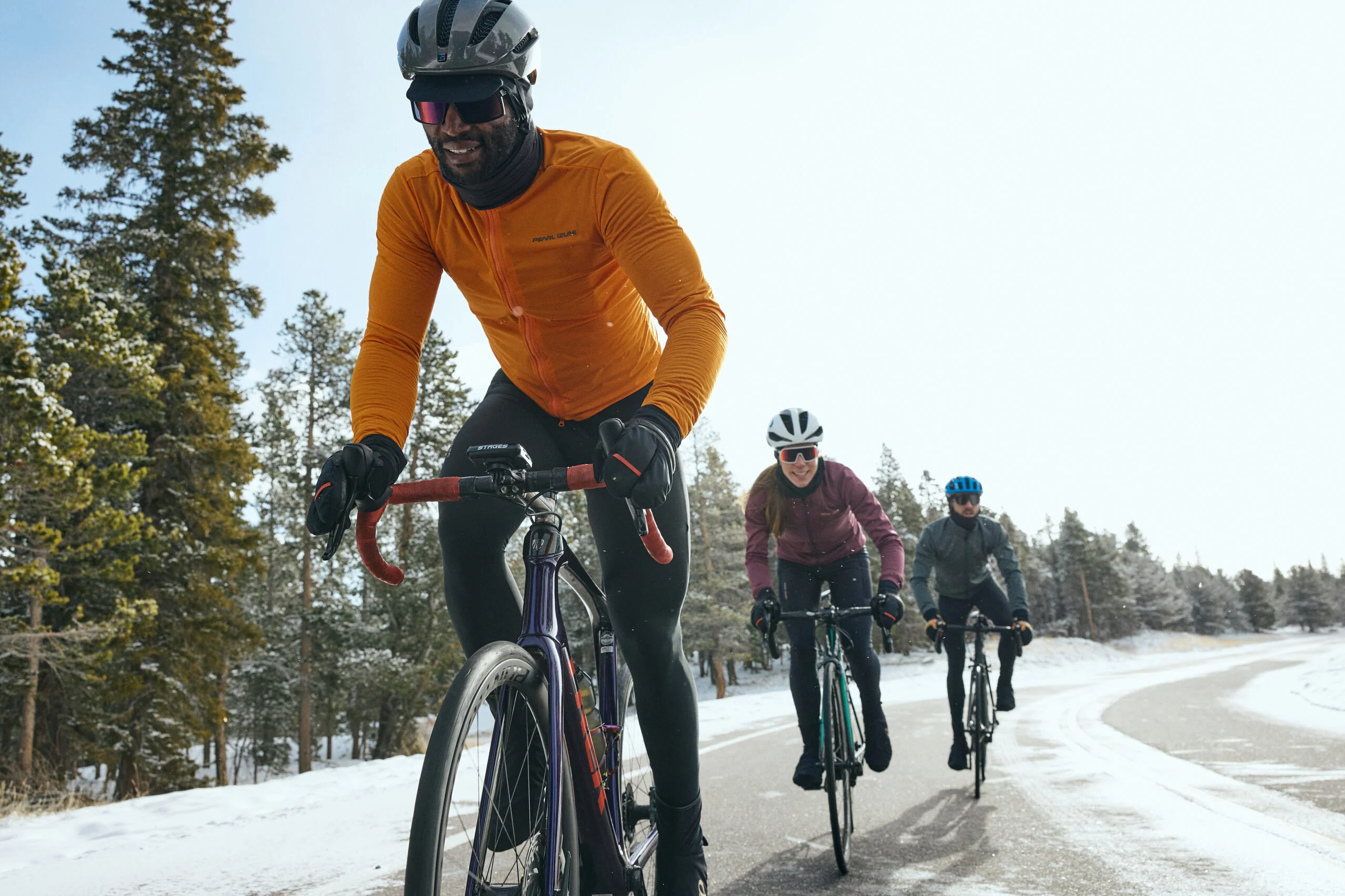
Cycling during the winter can be challenging but also rewarding. To enjoy your ride and stay comfortable, you must dress appropriately for the conditions.
The secret lies in the layering method.
Layering involves wearing multiple pieces of clothing you can adjust as your body temperature changes. It allows you to adapt to different factors, such as the time of day, the outside temperature, and the intensity of your ride. For example, you might start your ride feeling cold and then warm up as you pedal harder. Or you might feel colder when you go downhill after a climb.
In this article, I’ll explain how to layer your clothing for riding this winter, the types of clothing you need, and how to choose the best options for different temperature ranges.
The key to layering for cold-weather cycling
The key to layering for cold-weather cycling is experimenting with different combinations and finding out what works best for you. Here are some practical tips to help you layer effectively, based on my experience and the pros at EF Pro Cycling.
- Start your ride feeling slightly cold, as you will warm up quickly once you start pedaling.
- Dress for the weather, not for the season. Check the forecast and the wind chill factor before you head out, and dress accordingly.
- Choose clothing that is suitable for your riding style and intensity. For example, if you ride fast and hard, you may need less clothing than if you ride slow and easy.
- Choose clothing that fits well and allows you to move freely. Avoid clothing that is too tight or loose, as it may cause chafing or restrict blood circulation.
- Choose clothing that is easy to put on and take off, and that can be stored in your jersey pockets if needed.
- Choose breathable and moisture-wicking clothing with zippers, vents, and mesh panels to help regulate your body temperature and prevent overheating or sweating.
- Choose windproof and waterproof clothing with reflective details, hoods, and cuffs to help you stay dry and visible in low-light conditions.
- Choose warm and cozy clothing with features like fleece lining, high collars, and thumb loops to help you retain heat and prevent cold spots.
The three layers of cycling clothing

The basic principle of layering is to wear three layers of clothing: a base layer, a mid-layer, and an outer layer. Each layer has a different function and should be made of a suitable material.
Base layer
The base layer is the layer that sits closest to your skin and has two main purposes,
- to wick away sweat
- to keep you warm
The base layer should be made of a warm, breathable, moisture-wicking fabric, such as merino wool or polyester. The base layer should fit snugly but not too tightly and cover as much of your body as possible.
Some examples of base layers are:
- Rapha Merino Base Layer. A lightweight and soft base layer made of 100% merino wool that regulates your body temperature and wicks away moisture.
- Castelli Prosecco Tech Base Layer. A warm, stretchy polyester and nylon base layer has a mesh structure to enhance breathability and moisture management.
Mid-layer
The mid-layer is the layer that provides insulation and traps air between the base and outer layers, creating a layer of warmth. The mid-layer should be a warm, breathable fabric, such as fleece or wool. The mid layer should fit comfortably over the base layer, but not too loosely, and allow some freedom of movement.
Some examples of mid-layers are:
- Rapha Classic Long Sleeve Jersey II. Made of merino wool and polyester, it has a soft and cozy feel and a full-length zipper for ventilation.
- Castelli Perfetto RoS Long Sleeve Jersey. A windproof and water-resistant mid-layer made of Gore-Tex Infinium fabric with a fleece lining and a dropped tail for extra coverage.
Outer layer
The outer layer is the layer that protects you from the wind, rain, and snow.
The outer layer should be made of a windproof and waterproof fabric that is also breathable and allows excess heat and moisture to escape. The outer layer should fit snugly over the mid layer, but not too tightly, and have features such as zippers, vents, pockets, and reflective details.
Some examples of outer layers are:
- Rapha Pro Team Lightweight Shadow Jacket. A lightweight and packable outer layer made of a durable and stretchy fabric with a DWR coating and a high collar for protection.
- Castelli Idro Pro 2 Jacket. A waterproof and breathable outer layer made of Gore-Tex Shakedry fabric that has a slim fit and a two-way zipper for easy access to your jersey pockets.
How to choose the right clothing for different temperatures
The guide below is a good starting point that I use myself.
In the many years of cycling, I’ve seen many cyclists get creative with their layering options. The more you ride in cold conditions, the more you’ll get to know yourself and, eventually, discover the best layering options.
Dry, 40 to 55ºF (4 to 12ºC)
- Short sleeve lightweight merino base layer
- Long sleeve, summer jersey
- Wind vest (can be easily removed mid-ride as the pace and/or temperature goes up)
- Fleeced bib shorts
- Lightweight full-finger gloves
- Merino socks
- Toe covers
- Regular sunglasses
Wet, 40 to 55ºF (4 to 12ºC)
- Short sleeve mid-weight merino base layer
- Long sleeve, thermal jersey
- Rain jacket as a removable and packable outer layer if the showers get heavy (eg: Castelli Idro, Rapha Pro Team Gore-Tex Rain Jacket)
- Lightweight full-finger gloves
- ¾ bib knickers
- Shoe covers with water protection
- Clear or photochromic sunglasses
Dry, 20 to 40ºF (-7 to 4ºC)
- Short sleeve mid-weight merino base layer
- Long sleeve, thermal jersey
- Wind vest (can be easily removed mid-ride as the pace and/or temperature goes up)
- ¾ bib knickers
- Fleeced, full-finger gloves
- Merino socks
- Overshoes
- Beanie
- Regular sunglasses
Wet, 20 to 40ºF (-7 to 4ºC)
- Short sleeve mid-weight merino base layer
- Winter jacket with a waterproof membrane (eg: Castelli Alpha RoS)
- Rain jacket as a removable and packable outer layer if the showers get heavy (eg: Castelli Idro, Rapha Pro Team Gore-Tex Rain Jacket)
- Fleeced, full-finger gloves
- Bib tights
- Shoe covers with water protection
- Beanie
- Clear or photochromic sunglasses

Alex Lee is the founder and editor-at-large of Mr. Mamil. Coming from a professional engineering background, he breaks down technical cycling nuances into an easy-to-understand and digestible format here.
He has been riding road bikes actively for the past 12 years and started racing competitively in the senior category during the summer recently.